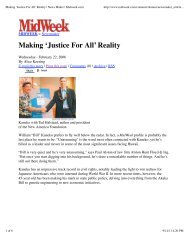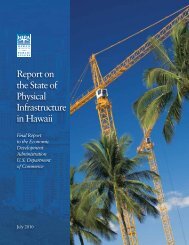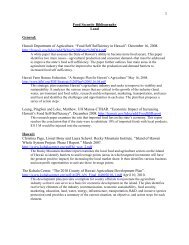Hawai'i Fisheries Initiative - The Hawaii Institute for Public Affairs
Hawai'i Fisheries Initiative - The Hawaii Institute for Public Affairs
Hawai'i Fisheries Initiative - The Hawaii Institute for Public Affairs
You also want an ePaper? Increase the reach of your titles
YUMPU automatically turns print PDFs into web optimized ePapers that Google loves.
With expected increases in population –<br />
Aquaculture<br />
as well as the heightened consumer<br />
awareness of seafood’s nutritional benefits –<br />
the U.S. is expected to need an additional<br />
supply of 2 million metric tons of seafood<br />
by 2025. 93 More than 80 percent of the<br />
seafood consumed by Americans is<br />
imported, with 40 percent of the imports<br />
from farmed seafood. 94<br />
Aquaculture (farming of fresh and saltwater<br />
plants and animals; also called mariculture<br />
as it pertains to saltwater aquaculture) is<br />
the fastest growing <strong>for</strong>m of food production<br />
in the world, and the U.S. government is<br />
eager to boost its market share. 95 In early<br />
2007, the Bush administration’s National<br />
Offshore Aquaculture Act of 2007 was<br />
sent to Congress, and is currently making<br />
its way through the legislative hearings<br />
process. 96 <strong>The</strong> economic driver <strong>for</strong> the Act<br />
is an $8 billion U.S. seafood trade deficit,<br />
and increased offshore aquaculture – fish<br />
and shellfish farming – is targeted to reduce<br />
that deficit, while providing additional<br />
jobs and income <strong>for</strong> coastal communities,<br />
and increasing regional food supply and<br />
security. 97 <strong>The</strong> possibilities of far-offshore<br />
aquaculture are distinguished from an<br />
established $1 billion state-waters-based<br />
aquaculture industry, dominated primarily<br />
by freshwater species like catfish and trout,<br />
and marine shellfish such as oysters, clams,<br />
and mussels. 98<br />
NOAA, which will take the lead on<br />
management of the proposed aquaculture<br />
industry in federal waters, suggests<br />
that offshore aquaculture is a means of<br />
addressing the widening gap between<br />
seafood demand and wild seafood supply. 99<br />
<strong>The</strong> offshore area is being targeted<br />
because there are fewer competing uses<br />
farther from shore, as well as the environmental<br />
considerations addressed by<br />
moving production into deeper water and<br />
stronger ocean currents. 100 Open-ocean<br />
demonstration and commercial operations<br />
are located in the state waters of Hawai‘i,<br />
New Hampshire, and Puerto Rico. 101<br />
<strong>The</strong> Act would establish legal processes<br />
<strong>for</strong> permits, en<strong>for</strong>cement, and monitoring.<br />
Highlights of the bill include:<br />
u Authorize the Secretary of Commerce to<br />
issue offshore aquaculture permits <strong>for</strong><br />
federal waters.<br />
u Require the Secretary of Commerce to<br />
establish environmental requirements<br />
and to coordinate with federal agencies<br />
to develop and implement a streamlined<br />
permitting process <strong>for</strong> offshore aquaculture.<br />
u Permitting and management of offshore<br />
aquaculture activities would be a joint ef<strong>for</strong>t<br />
between federal agencies and the state<br />
government (permitting will be done by<br />
NOAA/NMFS, with consultation by the state,<br />
other federal agencies, and the public).<br />
u Exempt permitted offshore aquaculture<br />
operations from fishing regulations that<br />
restrict size, season, and harvest methods.<br />
u Establish a research and development<br />
program that would allow NOAA to<br />
fund scientific research and technology<br />
development to facilitate expansion of<br />
marine aquaculture. 102<br />
26







